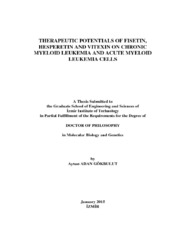Please use this identifier to cite or link to this item:
https://hdl.handle.net/11147/4275| Title: | Therapeutic Potentials of Fisetin, Hesperetin and Vitexin on Chronic Myeloid Leukemia and Acute Myeloid Leukemia Cells | Other Titles: | Fisetin, Hesperetin ve Viteksinin Kronik Miyeloid Lösemi ve Akut Miyeloid Lösemi Hücreleri Üzerine Terapötik Potansiyelleri | Authors: | Adan Gökbulut, Aysun | Advisors: | Baran, Yusuf | Keywords: | Cancer cells Leukemia Flavones |
Publisher: | Izmir Institute of Technology | Source: | Adan Gökbulut, A. (2015). Therapeutic potentials of fisetin, hesperetin and vitexin on chronic myeloid leukemia and acute myeloid leukemia cells.Unpublished doctoral dissertation, İzmir Institute of Technology, İzmir, Turkey | Abstract: | Fisetin, hesperetin and vitexin are plant-derived flavonoids. This thesis study aims to investigate therapeutic potentials of them on human HL60 APL and K562 CML cells since there are no studies on these cells. The effects of these compounds on APL and CML cells have been considered in terms of cytotoxicity, apoptosis and cell cycle progression. In this study, genome-wide microarray analysis has been also performed for APL and CML cells to identify the genes and networks that are responsible for fisetin and hesperetin-induced effects. In summary, we intented to explain the molecular mechanisms and global gene expression patterns related with the effects of these flavonoids on both APL and CML for the first time. There were decreases in the viability/proliferation of K562 and HL60 cells treated with fisetin, hesperetin and vitexin. Fisetin was the most effective flavonoid for the induction of apoptosis in both cells. Fisetin, hesperetin and vitexin have been found to affect cell cycle progression at different phases of the cell cycle in both CML and AML cells, thus having cytostatic effects. In conclusion, the results of this study indicated that especially fisetin and hesperetin may have therapeutic potential in APL and CML cells due to induction of apoptosis, inhibition of cell proliferation and cell cyle arrest. Moreover, the genetic networks derived from this study illuminate some of the biological pathways affected by fisetin and hesperetin treatment while providing a proof of principle for identifying candidate genes that might be targeted for CML and APL therapy. | Description: | Thesis (Doctoral)--Izmir Institute of Technology, Molecular Biology and Genetics, Izmir, 2015 Includes bibliographical references (leaves: 86-101) Text in English; Abstract: Turkish and English xi, 101 leaves |
URI: | http://hdl.handle.net/11147/4275 |
| Appears in Collections: | Phd Degree / Doktora |
Files in This Item:
| File | Description | Size | Format | |
|---|---|---|---|---|
| T001298.pdf | DoctoralThesis | 2.59 MB | Adobe PDF |  View/Open |
CORE Recommender
Page view(s)
490
checked on Apr 28, 2025
Download(s)
310
checked on Apr 28, 2025
Google ScholarTM
Check
Items in GCRIS Repository are protected by copyright, with all rights reserved, unless otherwise indicated.